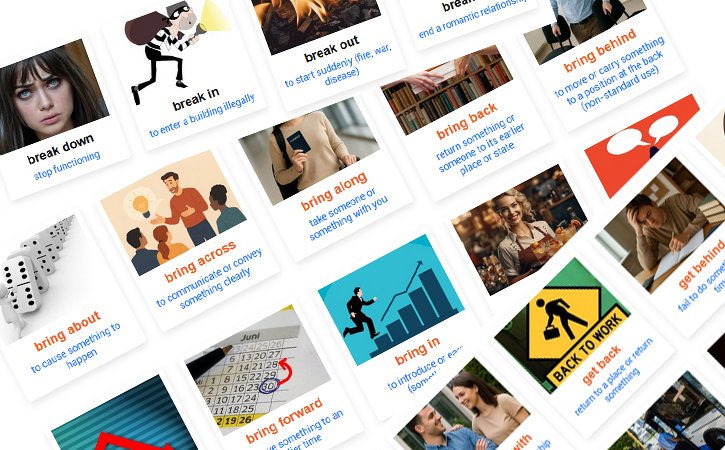Phrasal Verbs: the Key to English Fluency
Many learners try to study phrasal verbs as long vocabulary lists. That doesn’t work well: it’s boring and nothing sticks. A better way is to understand the image of the main verb. The particle only adds a shade of meaning, but the core idea comes from the verb itself.
In this guide we’ll look at eight “building blocks” of English: break, bring, come, fall, get, give, go, take. These verbs create hundreds of phrasal combinations, and once you feel their logic, learning becomes much easier.
Phrasal verbs with break
Core image: to break, interrupt, separate.
- Usually about splitting or stopping something: a car stops working, a relationship ends, a plan collapses.
- Even in abstract use it’s still a “rupture”: break off talks = stop negotiations.
Memory tip. Imagine a crack or split — every meaning of break fits this picture.
Phrasal verbs with bring
Core image: to carry, to bring, to introduce.
- Something is being moved or added: an idea, a person, a change.
- That’s why bring up = raise a topic, bring about = cause a result.
Memory tip. Think: “I bring something here.”
Phrasal verbs with come
Core image: movement toward, appearance.
- Always about approaching or reaching.
- come back = return, come up with = arrive at an idea.
Memory tip.Come means moving “here” — toward the speaker or toward a result.
Phrasal verbs with fall
Core image: falling, dropping, decline.
- It’s either literal downward movement or losing control: fall apart = collapse, fall behind = lag behind.
- Even figurative meanings are about going down.
Memory tip. Picture something falling down — physically or metaphorically.
Phrasal verbs with get
Core image: to obtain, to reach, to change state.
- Get shows movement into a new state or condition: get up = rise, get over = recover, get into = become involved.
- It’s the most flexible “transition” verb.
Memory tip.Get = “acquire, reach, move further.”
Phrasal verbs with give
Core image: to give, to hand over, to yield.
- The action goes away from you.
- give up = give away your effort, give away = donate or reveal, give back = return.
Memory tip. With give, something always leaves you.
Phrasal verbs with go
Core image: to move, to continue, to proceed.
- Not just “walking somewhere,” but processes in time.
- go on = continue, go through = experience or endure.
Memory tip.Go = movement forward, the flow of a process.
Phrasal verbs with take
Core image: to take, to accept, to assume.
- It points to grabbing or taking responsibility: take off = remove or fly, take over = assume control.
- Often about making something “yours.”
Memory tip.Take = to seize and make it your own.
How to Learn Them Effectively
- First, fix the core image of the base verb in your mind.
- Compare just 2–3 common phrasal combinations.
- Always look for the logic of meaning, not random memorization.
- Create your own examples — your brain remembers personal context best.
Conclusion
Phrasal verbs stop being chaotic once you see them through verb images:
- break — rupture
- bring — carry in
- come — approach
- fall — downward motion
- get — obtain/transition
- give — hand out
- go — process/movement
- take — seize, accept
With these models, you can guess the meaning of new phrasal verbs and use them more confidently in real life.

